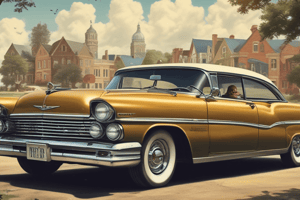Podcast
Questions and Answers
What social and economic changes did Prohibition in 1920 bring about in the United States?
What social and economic changes did Prohibition in 1920 bring about in the United States?
Prohibition led to the rise of organized crime, bootlegging, and speakeasies, significantly altering social dynamics and economic activities.
How did the Harlem Renaissance contribute to the cultural landscape of the 1920s?
How did the Harlem Renaissance contribute to the cultural landscape of the 1920s?
The Harlem Renaissance highlighted African American art, literature, and music, reshaping cultural perceptions and promoting racial pride.
What role did nativism play in shaping racial tensions in the 1910s and 1920s?
What role did nativism play in shaping racial tensions in the 1910s and 1920s?
Nativism fostered hostility towards immigrants and minorities, contributing to racial tensions and the revival of groups like the Ku Klux Klan.
Discuss the impact of mass media on American society during the 1920s.
Discuss the impact of mass media on American society during the 1920s.
What was the significance of the Great Migration for African Americans in the early 20th century?
What was the significance of the Great Migration for African Americans in the early 20th century?
How did crime rates change during the 1910s in response to the rise of organized crime?
How did crime rates change during the 1910s in response to the rise of organized crime?
In what ways did fundamentalism respond to the cultural shifts of the 1920s?
In what ways did fundamentalism respond to the cultural shifts of the 1920s?
What characterized the phenomenon of flappers in the 1920s?
What characterized the phenomenon of flappers in the 1920s?
Flashcards
Roaring Twenties Economics
Roaring Twenties Economics
The period of economic prosperity in the 1920s in the U.S.A., though masked deep-seated social inequalities.
Prohibition's Impact (1920)
Prohibition's Impact (1920)
Prohibition, the banning of alcohol, in 1920, led to a surge of organized crime and social shifts.
Harlem Renaissance
Harlem Renaissance
A cultural movement celebrating African American art, music, and literature.
Organized Crime (1920s)
Organized Crime (1920s)
Signup and view all the flashcards
Great Migration (1920s)
Great Migration (1920s)
Signup and view all the flashcards
Racial Tensions (1920s)
Racial Tensions (1920s)
Signup and view all the flashcards
1920s Cultural Trends
1920s Cultural Trends
Signup and view all the flashcards
Post-WWI Society
Post-WWI Society
Signup and view all the flashcards
Study Notes
- The 1910s and 1920s in the USA witnessed significant social and cultural shifts, alongside evolving crime rates.
Historical Context
- The period saw the aftermath of World War I, the rise of industrialization, and significant immigration waves, particularly from Southern and Eastern Europe.
- Prohibition was enacted in 1920, leading to significant social and economic changes.
- The economic prosperity of the "Roaring Twenties" masked underlying social inequalities.
- The rise of nativism and the resurgence of the Ku Klux Klan played a role in the rise of racial tensions.
Cultural History
- The Harlem Renaissance was a significant cultural movement emphasizing African American art, literature, and music.
- Jazz music emerged and gained popularity, reflecting the changing cultural landscape.
- Flappers epitomized a new era of women's fashion and independence.
- Mass media, including cinema and radio, became more prevalent and influenced popular culture.
- The pursuit of entertainment and leisure was a defining characteristic of the era.
Crime Trends
- Organized crime, particularly by Italian and Irish immigrant groups, began to flourish in response to Prohibition.
- The rise of bootlegging and speakeasies contributed to criminal activity.
- Gang warfare between competing criminal organizations became increasingly common and sensationalized in the media.
- Murder and other violent crimes rates fluctuations during this period and affected various segments of the population disproportionately.
- Crime data was not systematically and reliably collected at that time and reporting methods varied and potentially biased.
Race Relations
- Racial segregation and discrimination remained pervasive in the U.S. South and other areas.
- The Great Migration saw African Americans moving north in search of better economic opportunities. This unfortunately created increased racial tensions in Northern cities.
- Instances of racial violence, including lynchings and assaults, persisted.
- There was growing activism within African American communities.
Religion
- Fundamentalism emerged as a significant religious movement, often associated with rural communities, opposing the perceived secularization of society.
- Urban religious communities adapted to the changing social landscape, sometimes in response to crime and immorality perceived as increasingly rife.
- Religious beliefs sometimes coincided with or clashed with views on immigration and racial segregation.
- The role of religion in social reform and activism, both supporting and opposing certain movements, should be considered in understanding the time period's complexity.
- The role of religious organizations in supporting or opposing various trends in society is relevant in understanding the full context of this era. This involves considering their influence on issues like crime, race relations, and immigration policies.
Studying That Suits You
Use AI to generate personalized quizzes and flashcards to suit your learning preferences.




